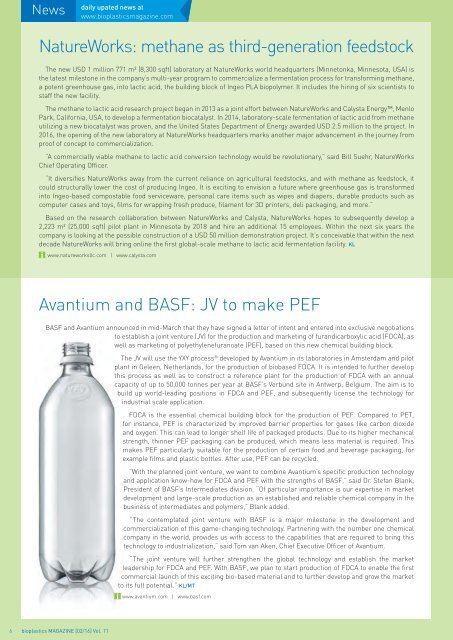Issue 02/2016
bioplasticsMAGAZINE_1602
bioplasticsMAGAZINE_1602
Create successful ePaper yourself
Turn your PDF publications into a flip-book with our unique Google optimized e-Paper software.
News<br />
daily upated news at<br />
www.bioplasticsmagazine.com<br />
NatureWorks: methane as third-generation feedstock<br />
The new USD 1 million 771 m² (8,300 sqft) laboratory at NatureWorks world headquarters (Minnetonka, Minnesota, USA) is<br />
the latest milestone in the company’s multi-year program to commercialize a fermentation process for transforming methane,<br />
a potent greenhouse gas, into lactic acid, the building block of Ingeo PLA biopolymer. It includes the hiring of six scientists to<br />
staff the new facility.<br />
The methane to lactic acid research project began in 2013 as a joint effort between NatureWorks and Calysta Energy, Menlo<br />
Park, California, USA, to develop a fermentation biocatalyst. In 2014, laboratory-scale fermentation of lactic acid from methane<br />
utilizing a new biocatalyst was proven, and the United States Department of Energy awarded USD 2.5 million to the project. In<br />
<strong>2016</strong>, the opening of the new laboratory at NatureWorks headquarters marks another major advancement in the journey from<br />
proof of concept to commercialization.<br />
“A commercially viable methane to lactic acid conversion technology would be revolutionary,” said Bill Suehr, NatureWorks<br />
Chief Operating Officer.<br />
“It diversifies NatureWorks away from the current reliance on agricultural feedstocks, and with methane as feedstock, it<br />
could structurally lower the cost of producing Ingeo. It is exciting to envision a future where greenhouse gas is transformed<br />
into Ingeo-based compostable food serviceware, personal care items such as wipes and diapers, durable products such as<br />
computer cases and toys, films for wrapping fresh produce, filament for 3D printers, deli packaging, and more.”<br />
Based on the research collaboration between NatureWorks and Calysta, NatureWorks hopes to subsequently develop a<br />
2,223 m² (25,000 sqft) pilot plant in Minnesota by 2018 and hire an additional 15 employees. Within the next six years the<br />
company is looking at the possible construction of a USD 50 million demonstration project. It’s conceivable that within the next<br />
decade NatureWorks will bring online the first global-scale methane to lactic acid fermentation facility. KL<br />
www.natureworksllc.com | www.calysta.com<br />
Avantium and BASF: JV to make PEF<br />
BASF and Avantium announced in mid-March that they have signed a letter of intent and entered into exclusive negotiations<br />
to establish a joint venture (JV) for the production and marketing of furandicarboxylic acid (FDCA), as<br />
well as marketing of polyethylenefuranoate (PEF), based on this new chemical building block.<br />
The JV will use the YXY process ® developed by Avantium in its laboratories in Amsterdam and pilot<br />
plant in Geleen, Netherlands, for the production of biobased FDCA. It is intended to further develop<br />
this process as well as to construct a reference plant for the production of FDCA with an annual<br />
capacity of up to 50,000 tonnes per year at BASF’s Verbund site in Antwerp, Belgium. The aim is to<br />
build up world-leading positions in FDCA and PEF, and subsequently license the technology for<br />
industrial scale application.<br />
FDCA is the essential chemical building block for the production of PEF. Compared to PET,<br />
for instance, PEF is characterized by improved barrier properties for gases like carbon dioxide<br />
and oxygen. This can lead to longer shelf life of packaged products. Due to its higher mechanical<br />
strength, thinner PEF packaging can be produced, which means less material is required. This<br />
makes PEF particularly suitable for the production of certain food and beverage packaging, for<br />
example films and plastic bottles. After use, PEF can be recycled.<br />
“With the planned joint venture, we want to combine Avantium’s specific production technology<br />
and application know-how for FDCA and PEF with the strengths of BASF,” said Dr. Stefan Blank,<br />
President of BASF’s Intermediates division. “Of particular importance is our expertise in market<br />
development and large-scale production as an established and reliable chemical company in the<br />
business of intermediates and polymers,” Blank added.<br />
“The contemplated joint venture with BASF is a major milestone in the development and<br />
commercialization of this game-changing technology. Partnering with the number one chemical<br />
company in the world, provides us with access to the capabilities that are required to bring this<br />
technology to industrialization,” said Tom van Aken, Chief Executive Officer of Avantium.<br />
“The joint venture will further strengthen the global technology and establish the market<br />
leadership for FDCA and PEF. With BASF, we plan to start production of FDCA to enable the first<br />
commercial launch of this exciting bio-based material and to further develop and grow the market<br />
to its full potential.” KL/MT<br />
www.avantium.com | www.basf.com<br />
6 bioplastics MAGAZINE [<strong>02</strong>/16] Vol. 11


















